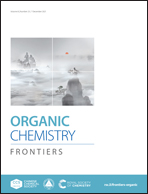Wanzlick's equilibrium in tri- and tetraaminoolefins†
Abstract
The dissociation mechanism of electron-rich olefins into their parent carbenes has been a controversial topic since Wanzlick's pioneering work. Herein, we present a combined synthetic and computational study on the formation (dissociation, respectively) of hetero- and homo-carbene dimers derived from benzimidazolin-2-ylidenes (benzNHCs), imidazolidin-2-ylidenes (saNHC), and cyclic (alkyl) (amino) carbenes (CAACs) through sublimation (in vacuo) as well as in condensed phase. We quantify the effect of proton catalysis and report that even triaminoolefins dissociate to their free carbenes, yet only under proton catalysis. Accordingly, we report how the judicious choice of the base (KOtBu vs. KHMDS) and solvent (hexane/benzene vs. THF) allows N,N′-dimethylbenzimidazolin-2-ylidene to be obtained quantitatively as a metastable, kinetic product. This free carbene had been previously reported to dimerize directly to the olefin-dimer, which is the thermodynamic product.

- This article is part of the themed collection: Recent Open Access Articles in Frontiers Journals


 Please wait while we load your content...
Please wait while we load your content...